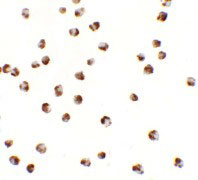YPEL3 Antibody
- 产品详情
- 实验流程
- 背景知识
Application
| WB, IF, ICC, E |
|---|---|
| Primary Accession | P61236 |
| Other Accession | NP_113665, 117956405 |
| Reactivity | Human, Mouse, Rat |
| Host | Rabbit |
| Clonality | Polyclonal |
| Isotype | IgG |
| Calculated MW | 13608 Da |
| Concentration (mg/ml) | 1 mg/mL |
| Conjugate | Unconjugated |
| Application Notes | YPEL3 antibody can be used for detection of YPEL3 by Western blot at 1 µg/mL. Antibody can also be used for immunocytochemistry starting at 2.5 µg/mL. For immunofluorescence start at 2.5 µg/mL. |
| Gene ID | 83719 |
|---|---|
| Other Names | Protein yippee-like 3, YPEL3 |
| Target/Specificity | YPEL3; |
| Reconstitution & Storage | YPEL3 antibody can be stored at 4℃ for three months and -20℃, stable for up to one year. As with all antibodies care should be taken to avoid repeated freeze thaw cycles. Antibodies should not be exposed to prolonged high temperatures. |
| Precautions | YPEL3 Antibody is for research use only and not for use in diagnostic or therapeutic procedures. |
| Name | YPEL3 |
|---|---|
| Function | Involved in proliferation and apoptosis in myeloid precursor cells. |
| Cellular Location | Nucleus, nucleolus. |
| Tissue Location | Widely expressed.. |
For Research Use Only. Not For Use In Diagnostic Procedures.
Provided below are standard protocols that you may find useful for product applications.
BACKGROUND
YPEL3 Antibody: YPEL3 (yippee-like 3) belongs to a family of five yippee-like proteins, all of which localize to the centrosome or mitotic spindle and are widely expressed in both adult and fetal tissue. This localization plus the fact that the family of human YPEL proteins share a high degree of sequence homology across species suggests that these proteins may have a conserved function involved in cell division. YPEL3 is a p53-regulated gene whose expression is induced by DNA damage and in turn induces cellular senescence. It appears to function as a tumor suppressor as it is downregulated in colon and breast tumors.
REFERENCES
Hosono K, Sasaki T, Minoshima S, et al. Identification and characterization of a novel gene family YPEL in a wide spectrum of eukaryotic species. Gene 2004; 340: 31-43.
Kelley K, Miller KR, Todd A, et al. YPEL3, a p53-regulated gene that induces cellular senescence. Cancer Res. 2010; 70:3566-75.
Tuttle R, Simon R, Hitch DC, et al. Senescence-associated gene YPEL3 is downregulated in human tumors. Ann. Surg. Oncol. 2011; 18:1791-6.
Tuttle R, Miller KR, Maiorano JN, et al. Novel senescence associated gene, YPEL3, is repressed by estrogen in ER+ mammary tumor cells and required for tamoxifen-induced cellular senescence. Int. J. Cancer 2011; epub.
终于等到您。ABCEPTA(百远生物)抗体产品。
点击下方“我要评价 ”按钮提交您的反馈信息,您的反馈和评价是我们最宝贵的财富之一,
我们将在1-3个工作日内处理您的反馈信息。
如有疑问,联系:0512-88856768 tech-china@abcepta.com.























 癌症的基本特征包括细胞增殖、血管生成、迁移、凋亡逃避机制和细胞永生等。找到癌症发生过程中这些通路的关键标记物和对应的抗体用于检测至关重要。
癌症的基本特征包括细胞增殖、血管生成、迁移、凋亡逃避机制和细胞永生等。找到癌症发生过程中这些通路的关键标记物和对应的抗体用于检测至关重要。 为您推荐一个泛素化位点预测神器——泛素化分析工具,可以为您的蛋白的泛素化位点作出预测和评分。
为您推荐一个泛素化位点预测神器——泛素化分析工具,可以为您的蛋白的泛素化位点作出预测和评分。 细胞自噬受体图形绘图工具为你的蛋白的细胞受体结合位点作出预测和评分,识别结合到自噬通路中的蛋白是非常重要的,便于让我们理解自噬在正常生理、病理过程中的作用,如发育、细胞分化、神经退化性疾病、压力条件下、感染和癌症。
细胞自噬受体图形绘图工具为你的蛋白的细胞受体结合位点作出预测和评分,识别结合到自噬通路中的蛋白是非常重要的,便于让我们理解自噬在正常生理、病理过程中的作用,如发育、细胞分化、神经退化性疾病、压力条件下、感染和癌症。








